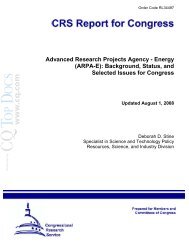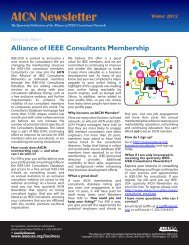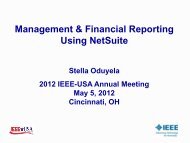Next Generation Internet: IPv4 Address Exhaustion ... - IEEE-USA
Next Generation Internet: IPv4 Address Exhaustion ... - IEEE-USA
Next Generation Internet: IPv4 Address Exhaustion ... - IEEE-USA
Create successful ePaper yourself
Turn your PDF publications into a flip-book with our unique Google optimized e-Paper software.
<strong>Next</strong> <strong>Generation</strong> <strong>Internet</strong>:<br />
<strong>IPv4</strong> <strong>Address</strong> <strong>Exhaustion</strong>, Mitigation<br />
Strategies and Implications for the U.S.<br />
An <strong>IEEE</strong>-<strong>USA</strong> White Paper<br />
2009<br />
1
This white paper was prepared by the Committee on Communications Policy of The<br />
Institute of Electrical and Electronics Engineers-United States of America (<strong>IEEE</strong>-<strong>USA</strong>). It<br />
represents the considered judgment of a group of U.S. <strong>IEEE</strong> members with expertise in the<br />
subject field. A roster of committee members is provided in the Appendix.<br />
Whitepapers are designed to provide balanced information on public policy issues in<br />
technology-related areas that may affect the interests of technical professionals. This<br />
document does not constitute a formal position statement of the <strong>IEEE</strong>-<strong>USA</strong>, and its contents<br />
do not necessarily reflect the views of <strong>IEEE</strong>-<strong>USA</strong>, <strong>IEEE</strong> or other <strong>IEEE</strong> organizational units.<br />
<strong>IEEE</strong>-<strong>USA</strong> has issued this whitepaper to enhance knowledge and promote discussion of the<br />
issues addressed. <strong>IEEE</strong>-<strong>USA</strong> advances the public good and promotes the careers and<br />
public policy interests of more than 210,000 engineers, scientists and allied professionals<br />
who are U.S. members of <strong>IEEE</strong>. <strong>IEEE</strong>-<strong>USA</strong> is part of <strong>IEEE</strong>, the world’s largest technical<br />
professional society with 375,000 members in 160 countries.<br />
2
TABLE OF CONTENTS<br />
EXECUTIVE SUMMARY ............................................................................................................... 5<br />
INTRODUCTION ......................................................................................................................... 5<br />
<strong>Internet</strong> <strong>Address</strong>ing ........................................................................................................................................ 7<br />
The Routing Table ...................................................................................................................................... 7<br />
Networks ...................................................................................................................................................... 7<br />
Network Classes ......................................................................................................................................... 8<br />
<strong>IPv4</strong> <strong>Address</strong> Shortage .................................................................................................................................. 8<br />
POSTPONING THE UPCOMING CRISIS ....................................................................................... 9<br />
The Prefix ......................................................................................................................................................... 9<br />
NAT – Public to Private Networks ............................................................................................................. 10<br />
Dynamic <strong>IPv4</strong> <strong>Address</strong> Allocation .............................................................................................................. 10<br />
Scarce Resource Allocation: Economic Theory ......................................................................................... 11<br />
ISSUES WITH IPV4 ADDRESS SHORTAGE MITIGATION ............................................................ 12<br />
Issues with CIDR ............................................................................................................................................. 12<br />
Issues with NAT .............................................................................................................................................. 12<br />
NAT Inhibits <strong>Internet</strong> Innovation ............................................................................................................. 13<br />
NAT Interferes with Policy Enforcement ............................................................................................... 13<br />
NAT Impacts Current <strong>Generation</strong> of Rich <strong>Internet</strong> Applications ...................................................... 13<br />
NAT Endpoint Thwarts End-to-End Transport Precept ...................................................................... 14<br />
Issues with NAT and Dynamic <strong>IPv4</strong> <strong>Address</strong> Allocation ......................................................................... 14<br />
Issues with Free-Market Allocation ............................................................................................................ 14<br />
Lock-In of Status Quo ................................................................................................................................... 15<br />
IPV6 .......................................................................................................................................... 16<br />
Implications of IPv6 Changes ..................................................................................................................... 16<br />
Hurdles to IPv6 Adoption ............................................................................................................................ 16<br />
3
Technology Availability .......................................................................................................................... 16<br />
Application Availability .......................................................................................................................... 16<br />
Renumbering ............................................................................................................................................. 17<br />
Operational Experience ......................................................................................................................... 18<br />
<strong>Internet</strong> Infrastructure Readiness ........................................................................................................... 18<br />
Cost and Time ........................................................................................................................................... 19<br />
Summary of Issues .................................................................................................................................... 20<br />
Worldwide IPv6 Deployment .................................................................................................................... 21<br />
Japan ......................................................................................................................................................... 22<br />
France ......................................................................................................................................................... 23<br />
China........................................................................................................................................................... 23<br />
Korea .......................................................................................................................................................... 23<br />
Australia ..................................................................................................................................................... 23<br />
<strong>USA</strong> ............................................................................................................................................................. 23<br />
APPENDIX: 2009 <strong>IEEE</strong>-<strong>USA</strong> CCP MEMBERSHIP ROSTER ........................................................... 23<br />
4
Executive Summary<br />
The number of <strong>Internet</strong> Protocol Version 4 (<strong>IPv4</strong>) addresses, while vast, is finite. The reserves are<br />
diminishing. Authorities predict address exhaustion within a few years.<br />
<strong>IPv4</strong> address exhaustion shares many of the characteristics of the Year 2000 issue, where many<br />
deployed systems only used a two-digit code for the year. For example, the estimated date for<br />
<strong>IPv4</strong> address exhaustion is currently predicted to be 2013 – and that date is considered<br />
conservative. When the IETF published the <strong>IPv4</strong> specification in 1981, the U.S. population was<br />
under 250,000,000, and the world population was around 4.5 billion. In September of that year,<br />
RFC 790 listed 43 networks in existence. One could see how it would be reasonable that an<br />
addressing scheme that gives almost the entire world population an individual IP address, and<br />
allows for more than two million networks, would last a long time. In fact, it has almost thirty years.<br />
Unlike the Year 2000 issue, where programs that were expected to fail once the clock chimed<br />
midnight on Dec. 31, 1999, running out of <strong>IPv4</strong> addresses will not cause immediate world-wide<br />
system crash. The Social Security Administration will still be able to calculate payments and write<br />
checks. Manufacturing systems will continue to run. However, the effects of running out of <strong>IPv4</strong><br />
addresses are more insidious. For example,<br />
• New hosts cannot connect directly to the <strong>Internet</strong><br />
• Many new, innovative applications cannot be used by new entrants<br />
• New entrants cannot use full, peer-to-peer <strong>Internet</strong> technologies to deliver innovative<br />
applications<br />
Moreover, most of the <strong>IPv4</strong> address exhaustion mitigation strategies rely on network service<br />
providers to act as gatekeepers to selectively issue temporary <strong>IPv4</strong> addresses to users. Allocating<br />
temporary addresses has technical problems discussed below, such as limiting users to existing<br />
applications. The impact of <strong>IPv4</strong> address exhaustion includes policy issues, in that it can be used in<br />
a predatory manner to keep competitive services out of the reach of a service provider’s customer<br />
base.<br />
This paper is limited to the examination of the technical issues surrounding the depletion of <strong>IPv4</strong><br />
addresses.<br />
The paper also reviews replacement strategies. Currently, IPv6 is the most widely cited<br />
replacement candidate for <strong>IPv4</strong>. This paper discusses IPv6 only as an example replacement. This<br />
paper is not intended to exclusively endorse IPv6 as the sole replacement structure and strategy<br />
for <strong>IPv4</strong>. Indeed, the lack of adoption for IPv6, which is an aging alternative, may indicate that<br />
preventing premature <strong>IPv4</strong> exhaustion is another viable strategy.<br />
Introduction<br />
It is widely recognized by many authorities that the global demand for <strong>Internet</strong> Protocol Version 4<br />
(<strong>IPv4</strong>) addresses will outstrip the availability to new entities seeking a connection to the <strong>Internet</strong>, or<br />
5
existing networks wanting to expand. 1 There is some debate as to whether that will occur in 2010<br />
or 2011. Even with new mitigation approaches, this date extends only to 2013. <strong>Address</strong><br />
exhaustion will have significant impact on American competitiveness and our economy.<br />
The many technologies that greatly benefit from being <strong>Internet</strong>-connected include the following:<br />
• Intelligent highway systems and vehicular technology<br />
• Distributed generation of renewable energy<br />
• Rechargeable batteries for PCs and Cell Phones<br />
• Motor vehicle event data recording<br />
• Motor vehicle maintenance and proactive service<br />
• Public key infrastructure certificate issuing and management components<br />
As important to American competitiveness are those applications that have not yet emerged.<br />
Imagine the possibilities of networking millions or billions of devices on a common infrastructure,<br />
with the center of research, development and monetizing here in the United States.<br />
These, and other applications, are at risk when we run out of <strong>IPv4</strong> addresses. Besides the numerous<br />
<strong>IEEE</strong> technical publications on this topic, the <strong>Internet</strong> Society, 2 NANOG, 3 and the IPv6 Forum 4 have<br />
position papers describing the exhaustion of <strong>IPv4</strong> and the impact that can have on technological<br />
development.<br />
The purpose of this white paper is to present the following:<br />
• Existing and proposed <strong>IPv4</strong> address exhaustion mitigation schemes<br />
• An examination of one of the long-term proposals: an update to the <strong>Internet</strong> Protocol<br />
called IPv6, recognizing the current challenges of transitioning from <strong>IPv4</strong> to IPv6, reasons<br />
for the change, and anticipated innovations and implications for the U.S.<br />
• Predictions of the NIST/NTIA report, Technical And Economic Assessment of <strong>Internet</strong> Protocol<br />
Version 6 (IPv6) 5<br />
1 https://www.arin.net/knowledge/about_resources/ceo_letter.pdf<br />
2 http://www.isoc.org<br />
3 http://www.nanog.org<br />
4 http://www.ipv6forum.org<br />
5 IPv6 Task Force (NIST and NTIA), Technical and Economic Assessment of <strong>Internet</strong> Protocol Version 6 (IPv6), U.S.<br />
Department of Commerce, January 2006. That paper was based on research, surveys, a request for comments, and a<br />
public meeting in June of 2004. Four years on, we can see where the report correctly assessed market forces and<br />
where it missed the mark in terms of IPv6 diffusion and the general capability deployed today.<br />
6
<strong>Internet</strong> <strong>Address</strong>ing -- Some Basics<br />
The <strong>Internet</strong> Protocol (IP) 6 is the dominant network protocol upon which many successful and<br />
ubiquitous global applications run.<br />
The HyperText Transfer Protocol (HTTP), or the Web (as we know it), uses IP. The Session Initiation<br />
Protocol (SIP) and the Real-Time Protocol (RTP), that collectively create Voice-Over-IP, are based<br />
on IP. Even proprietary application protocols such as Skype, and non-<strong>Internet</strong> protocols, such as<br />
Windows File Sharing, run over IP.<br />
In the <strong>Internet</strong> Protocol, each host has one or more <strong>Internet</strong> address, or “IP addresses.” The IP<br />
address in <strong>IPv4</strong> is 32-bits long. Each IP address has two parts, a network number and a host<br />
address. Each host has a unique IP address. Some hosts may have multiple IP addresses usually to<br />
provide redundant network paths to the host.<br />
The Routing Table<br />
At the <strong>Internet</strong> Protocol’s core is the ability to route data in the form of packets between networks.<br />
This way of routing the data is how we create a network of networks, or the <strong>Internet</strong>. The design<br />
goal is to enable sites to set up and manage their own networks, yet allow transport providers the<br />
ability to easily route packets between these networks.<br />
One important engineering issue with routing packets is the size and complexity of the routing<br />
table, which sets up and provides the associations of routers and addresses. It is theoretically<br />
possible for network routers to have an entry for every host. However, that would require possibly<br />
billions of entries the router would need to search and store in memory. Since routers operate in<br />
the realm of nano- and microseconds, it is not realistic to store all of this information on a disk.<br />
Moreover, the sheer number of updates to the locations of every host on the <strong>Internet</strong> would flood<br />
the network with network update messages.<br />
Networks<br />
<strong>Internet</strong> routers solve the routing scale problem by breaking each IP address into a network<br />
number and a host number on that network.<br />
Networks vary greatly in size. Consumer networks, such as a broadband cable company or 3G<br />
wireless provider, can have millions of hosts. A large enterprise, such as a large research university<br />
or multinational corporation, may have thousands of hosts. The other extreme would be a home<br />
user with a single device. Clearly, it would be inefficient to have a fixed-size network number.<br />
If the length of the network number is long, then each network would have only a few hosts,<br />
meaning the large enterprises would need many, many networks. Moreover, routers that need to<br />
determine where to send a packet would have to look up very large routing tables.<br />
If the length of the network number is short, with a lot of hosts on the network, then small networks<br />
would have many, many unused host addresses. Unused host addresses results in the waste of IP<br />
addresses, as other users cannot use these unallocated IP addresses within a network.<br />
6 RFC 791<br />
7
Network Classes<br />
<strong>IPv4</strong> introduced network classes to classify the finite composition of the <strong>Internet</strong>. The following<br />
table shows the number of networks and hosts each network class can theoretically have:<br />
Networks and Hosts per Class<br />
Network Class Number of Networks Number of Hosts<br />
A 126 16,777,214<br />
B 16,382 65,534<br />
C 2,097,150 254<br />
Table 1: Networks and Hosts Per Class<br />
Observing this table, there are some points to note. First, there are far fewer than the two 32<br />
possible hosts available if we used the full 32-bits of the address. Each network has at least one<br />
special host address for broadcast, and, (for legacy reasons) most networks reserve two. In<br />
addition, there are 271 networks reserved for private networks 7 . Thus, of the roughly four billion<br />
possible addresses (32-bits) theoretically available, over 600 million are not available. Moreover,<br />
if a Class C network only has, say, 54 hosts on it, 200 possible host addresses will not be<br />
available for other enterprises to use. This occurs because such a class C network has 254<br />
addresses associated with it. If the network only uses 54 addresses, then other users cannot use the<br />
remaining 200 addresses; only the enterprise with the aforementioned class C network can use<br />
them.<br />
<strong>IPv4</strong> <strong>Address</strong> Shortage<br />
Other reasons for IP address unavailability include new applications. For example, the 3G mobile<br />
network on its own can easily consume a billion addresses. At current rates of consumption, there<br />
will be no <strong>IPv4</strong> networks available for allocation by 2011. 8 Running out of addresses does not<br />
mean the <strong>IPv4</strong>-based <strong>Internet</strong> will suddenly stop working. However, it does mean it will be difficult,<br />
if not impossible, to distribute new IP addresses to new or expanding enterprises. Such a limitation<br />
will have clear impacts on commerce and innovation.<br />
Is this shortage a problem or an opportunity?<br />
One could argue it would be in the United States’ interest to let the address space fill up. The U.S.<br />
Government and U.S. enterprises hold the vast majority of allocated <strong>IPv4</strong> addresses. Of course,<br />
the United States is not the only country with <strong>Internet</strong> researchers and commerce. However, a<br />
number of countries, most notably China, Japan, Korea, and some European countries, have<br />
implemented IPv6.<br />
7 RFC 1918<br />
8 http://www.potaroo.net/tools/ipv4/index.html<br />
8
Hoarding <strong>IPv4</strong> addresses and postponing IPv6 deployment means the United States risks becoming<br />
an island in the global, next-generation <strong>Internet</strong>. That is, our servers might not be reachable from<br />
outside the U.S., and our clients will not be able to reach new, modern services offered overseas.<br />
Worse, with more IPv6 deployment experience and access, one can logically expect innovation<br />
and wealth-creation to occur elsewhere.<br />
Postponing the Upcoming Crisis<br />
Some technologies have been employed to postpone the exhaustion of network numbers. The most<br />
prevalent are Network <strong>Address</strong> Translation (NAT) 9 , Classless Inter-Domain Routing (CIDR) 10 , and<br />
dynamic <strong>IPv4</strong> address assignment (DHCP). 11<br />
In the late 1980s, when it was first recognized that the <strong>IPv4</strong> address space was finite, projections<br />
targeted 1995 as the year when address exhaustion would be realized. At that time, Class B<br />
networks were at a premium. Most medium-sized enterprises needed more then the 255 hosts<br />
available on a Class C network, but few needed the 65535 hosts available on a Class B network.<br />
The Prefix<br />
Rather than having three classes of network sizes, the fundamental concept in CIDR is to have a<br />
network identifier associated with the length of a prefix. The prefix is the number of bits that<br />
indicate the network identifier. The rest of the bits in the IP address are the host number. Thus,<br />
Class A networks have an 8-bit prefix, Class B networks have a 16-bit prefix, and Class C<br />
networks have a 24-bit prefix. In conjunction with the modification of the routing protocol, address<br />
allocation was made such that <strong>Internet</strong> service providers (ISPs) could advertise aggregated routes.<br />
These route advertisements increase the efficiency and decrease the latency of route processing.<br />
Thus, for example, a Regional <strong>Internet</strong> Registry (RIR) could allocate a Class B network to an ISP<br />
and then the ISP could use that single network to offer mid-size enterprises -- for example, a<br />
network with a 20-bit prefix. We denote such a network as a /20 net. The number after the slash<br />
is the number of bits in the prefix. As an example, a Class C network is a /24 CIDR net.<br />
Why is this slash important? Many enterprises fall into the 4,000-host size. Without CIDR, these<br />
enterprises need a full Class B network. With 65535 <strong>IPv4</strong> addresses in a Class B network, the<br />
enterprise will not use over 60,000 <strong>IPv4</strong> addresses from their network allocation. With CIDR, the<br />
ISP can create sixteen /20 networks. Each /20 network can have 4091 <strong>IPv4</strong> addresses. If we look<br />
at the losses for servicing 16 enterprises, one would lose close to a million addresses using 16<br />
underused Class B networks (16 enterprises times the 60,000 addresses not used per enterprise).<br />
Using CIDR and sixteen /20 networks, one loses under 2,000 addresses (16 enterprises times 91<br />
addresses not used), for a recapturing of four orders of magnitude worth of addresses.<br />
At the time of the original CIDR proposal (1992), 12 it was anticipated CIDR would extend <strong>IPv4</strong><br />
address exhaustion by three to five years.<br />
9 RFC 3022<br />
10 RFC 4632<br />
11 RFC 2131<br />
9
NAT -- Public to Private Networks<br />
The next technology used to extend the IP address space is Network <strong>Address</strong> Translation, or NAT.<br />
This extension also continued to postpone <strong>IPv4</strong> address exhaustion.<br />
A NAT translates one or more public IP addresses to one or more private IP networks. Private IP<br />
networks are networks that, by design, one cannot access from the <strong>Internet</strong>. Private networks 7<br />
include the Class A network 10, the Class B networks 172.16 through 172.31, and the Class C<br />
networks 192.168.0 through 192.168.255.<br />
These private networks may be familiar to consumers. Most residential routers automatically set up<br />
the home network with one of the Class C private networks. Many consumer <strong>Internet</strong> service<br />
providers (ISPs) use the Class A private network.<br />
Manufacturers of network devices often combine the NAT function with a router, as in a residential<br />
or wireless router, and a firewall. However, the routing function, routing packets from one network<br />
to another, and the firewall function, blocking packets based on source, destination, or other<br />
criteria, is distinct from the NAT function, which creates a single IP address that routes to a private<br />
network.<br />
It is unquestionable the use of NAT that has mitigated the exhaustion of <strong>IPv4</strong> addresses. Consumers<br />
do not have to get individual, publicly routable IP addresses from their ISP or from their regional<br />
<strong>Internet</strong> registry (RIR; in the U.S., ARIN) for each of their devices in their home and then configure<br />
those devices by hand. For the ISP, they only have to allocate a single IP address for the customer,<br />
Thus the ISP has more addresses available to service more customers.<br />
Dynamic <strong>IPv4</strong> <strong>Address</strong> Allocation<br />
A client finds a server by looking up the server’s IP address given the server’s domain name, like<br />
www.ieeeusa.org. The client uses a distributed directory, called the Domain Name System, or<br />
DNS. 13 The indirection serves multiple purposes. First, humans can read and relate to a domain<br />
name versus an IP address. People often attach meaning to the names. Second, by giving a name<br />
to <strong>Internet</strong> resources, there is a separation of the resource from different networks, administrative<br />
organizations, service providers, and network protocols. The result of this separation means one<br />
can change the IP address of their server without changing the name of the server. In addition, by<br />
listing multiple addresses for a given name, a client can try different addresses, in the event a<br />
particular instance of the server is not available due to traffic load. This mechanism is one of the<br />
principal mechanisms for achieving <strong>Internet</strong> scale and reliability. For example, a host could have<br />
two IP addresses, one going through a first ISP and the other going through a second ISP, each<br />
with their own facilities and connectivity. Thus, if a given ISP fails, the host remains connected to the<br />
<strong>Internet</strong>, and is still accessible by the same domain name.<br />
To minimize the expense and delays associated with this mapping technique, the DNS caches the<br />
mappings from host name to IP address in various places in the <strong>Internet</strong>. Thus, to ensure a good<br />
12 RFC 1338<br />
13 RFC 1034<br />
10
user experience or to meet latency requirements, it is beneficial for server IP addresses to be<br />
relatively static.<br />
Some applications, such as basic web browsing, do not need a client with a fixed IP address. One<br />
method of <strong>IPv4</strong> address exhaustion mitigation is to allow different clients to share the same IP<br />
address at different times. This “sharing” is particularly useful for dial-up networking. When a<br />
client connects to the <strong>Internet</strong>, their ISP allocates an IP address. The protocol for this is the Dynamic<br />
Host Configuration Protocol, or DHCP. 14<br />
When the client disconnects, the ISP puts the previously allocated IP address into a pool. After a<br />
period of time, to avoid recently contacted servers from sending packets to the wrong device, the<br />
ISP can allocate the <strong>IPv4</strong> address to the next user, who attaches to that particular subnet.<br />
The amount of <strong>IPv4</strong> addresses reused by this method depends on the statistics of client connectivity.<br />
An ISP with clients that connect briefly, spread out through the day, can see some IP address<br />
recovery. Conversely, if many of the ISP’s customers connect at the same time, the benefits are not<br />
as great. Likewise, there is no savings for always-on connections, such as cable broadband<br />
<strong>Internet</strong>, which is the predominant access mode in the U.S. 15<br />
Scarce Resource Allocation: Economic Theory<br />
<strong>IPv4</strong> addresses are essentially free to ISPs, although some ISPs do charge their customers for the<br />
addresses. The <strong>Internet</strong> Corporation for Assigned Names and Numbers (ICANN) allocates blocks of<br />
addresses to Regional <strong>Internet</strong> Registries (RIRs). RIRs are free to allocate blocks of addresses to<br />
ISPs. There may be a nominal registration fee for the address, but often the ISP bundles the fee<br />
with hosting charges or domain name registration.<br />
One way of dealing with scarcity is to allow the market to allocate resources. Auctioning or selling<br />
the remaining <strong>IPv4</strong> addresses is one possible distribution technique. Regions that typically<br />
underutilize their allocation, such as Africa, could generate income and put their addresses to<br />
productive use by selling their unused addresses. Of course, selling addresses makes it that much<br />
more expensive for these developing countries to join the global <strong>Internet</strong>, once their technological<br />
or financial capacity justifies connection to the <strong>Internet</strong>.<br />
Most RIRs have the right to reclaim unused network addresses. However, nothing prevents an<br />
enterprise from hoarding addresses. By creating a market for addresses, there will be more<br />
incentive to relinquish those addresses.<br />
Likewise, if a consumer does not mind being locked-in to today’s limited <strong>Internet</strong> services, or<br />
restricted to content retrieval only, they can chose an ISP that gives them a NATed DHCP address.<br />
The following section describes these limitations in more detail. This service would consume only a<br />
single <strong>IPv4</strong> address, shared by possibly thousands of other uses with the same restricted class of<br />
service. Thus, the service should be much less expensive than a real <strong>Internet</strong> service.<br />
14 RFC 2131<br />
15 http://www.websiteoptimization.com/bw/0704/<br />
11
RIPE (Réseaux IP Européens) in Europe at the end of 2008 was experimenting with creating a<br />
market to allocate <strong>IPv4</strong>. 16<br />
Issues with <strong>IPv4</strong> <strong>Address</strong> Shortage Mitigation<br />
While the techniques described above have somewhat alleviated the <strong>IPv4</strong> address shortage, the<br />
mitigation comes at a cost.<br />
Issues with CIDR<br />
The use of CIDR poses two issues. The first issue results from subnetting into classes. Recall that with<br />
CIDR the ISP aggregates sub-netted Class A and Class B networks. In the example given above in<br />
the CIDR section, 16 enterprises share a single Class B network, yet each has its own /20 network.<br />
This solution is fine -- unless the enterprise chooses to change ISPs. If the enterprise changes ISPs,<br />
there are two choices, neither of which is ideal:<br />
• The first choice is to add the enterprise’s /20 network number to the global routing tables.<br />
The problem is that as more enterprises change ISPs, the global routing tables become<br />
extremely large and inefficient. 17<br />
• The second choice is for the enterprise to change all of their hosts’ <strong>IPv4</strong> addresses to match<br />
the new network identifier assigned by their new ISP. Changing these addresses can be<br />
extremely costly, and is often taken only as a last resort by enterprises. 18 The second issue<br />
with CIDR is many enterprises, particularly those with mission-critical applications, or those<br />
that rely on <strong>Internet</strong> connectivity for their business, will use multiple, redundant ISPs for<br />
connectivity. One implication of this is that two ISPs would own the routes for what may not<br />
be a Class A, B, or C network. This problem is not insurmountable, in that it has essentially<br />
the same cost in terms of routing table size as when we had class-full routing.<br />
Issues with NAT<br />
The problems with NAT are much more significant. The model for NAT is fundamentally one of<br />
asymmetric data access. That is, access to the <strong>Internet</strong> is primarily from the private network, and<br />
not the other way around. For an enterprise, most of the traffic is internal to the private network. It<br />
is presumed that there is only occasional need for hosts in the enterprise to reach outside the<br />
private network. Likewise, for a consumer, the consumer will only be retrieving data from the<br />
public <strong>Internet</strong>.<br />
At first, many enterprises and consumers considered this model to provide enhanced security. What<br />
could be wrong with hiding the topology of an enterprise network, or making it impossible for a<br />
host on the <strong>Internet</strong> to access a consumer’s computer?<br />
16 http://www.ripe.net/ripe/docs/ipv4‐policies.html#55<br />
17 RFC 2008<br />
18 There are new technologies, such as IP <strong>Address</strong> Management that can make renumbering easier. See, e.g.,<br />
http://www.bluecatnetworks.com/demo/IPv6.pdf.<br />
12
It turns out the model breaks quite a lot. Worse, NAT does not provide security, as most enterprise<br />
security breaches occur inside the enterprise network.<br />
NAT Inhibits <strong>Internet</strong> Innovation<br />
Asymmetric data access interferes with one of the founding principles of the <strong>Internet</strong>: the end-toend<br />
principal. 19 Failure to adhere to the <strong>Internet</strong> architecture has already shown user-level<br />
problems. For example, applications that depend on IP addresses, such as FTP and Voice-over-IP,<br />
are broken by NAT. It is possible to extend a NAT with application-layer gateways (ALG) that<br />
repair the damage done by NAT. However, that has two implications. First, one cannot deploy<br />
new <strong>Internet</strong> applications without the cooperation of the NAT vendors. Even in the unlikely event<br />
the NAT vendors do cooperate and update their software, people with old NAT equipment will not<br />
be able to use the new application.<br />
NAT has important policy implications, as NAT effectively freezes new application deployment.<br />
For example, the widespread use of NAT is one of the factors that postponed the deployment of<br />
Voice-Over-IP by a number of years.<br />
NAT Interferes with Policy Enforcement<br />
The principal asymmetric data access protocol is HTTP in support of Web browsing. Although NATs<br />
and firewalls interfere with <strong>IPv4</strong> addressing, they try to minimize damage to traffic traveling over<br />
<strong>IPv4</strong> port 80, the HTTP port. What happens is developers that try to innovate on the <strong>Internet</strong> find<br />
they have to use port 80 to work around NATs and firewalls. The problem with reusing port 80 is<br />
it means one cannot apply policies to <strong>Internet</strong> traffic at an enterprise’s boarders. For example, the<br />
federal government requires some enterprises, such as financial services firms, to record all<br />
interactions with customers. With applications that follow <strong>Internet</strong> architectural guidelines, such<br />
recording is not a problem: the boarder element can monitor requests over communications ports,<br />
such as 5060 for SIP or 5190 for AIM. However, with NATs and firewalls present and applications<br />
tunneling traffic through port 80, we now have communication traffic masquerading as Web<br />
browsing. This reuse of port 80 could inadvertently put the enterprise out of compliance. Likewise,<br />
hosts receiving traffic cannot identify the source of the traffic if it is behind a NAT. Such an<br />
architecture again may have implications for an enterprise’s ability to comply with federal or local<br />
laws, or applicable governance statutes.<br />
NAT Impacts Current <strong>Generation</strong> of Rich <strong>Internet</strong> Applications<br />
Recall that NAT allows multiple clients to share an IP address. A major problem with multiple-client<br />
sharing is there are only about 64000 IP port numbers available per address. 20 Large servers<br />
overcome this limitation by presenting multiple IP addresses to the <strong>Internet</strong>. However, the port<br />
number limitation is becoming a real problem for clients behind NATs, particularly behind multiple<br />
levels of NAT. For example, if 2000 clients are behind a single IP address, then each client can<br />
have at most about 30 sessions to the <strong>Internet</strong>. Most browsers easily consume four sessions each;<br />
peer-to-peer applications consume four to ten each; mail consumes two- to five- sessions each, and<br />
19 RFC 1958<br />
20 While the port number is a 16‐bit quantity and thus one could have 65536 ports at an IP address, many of those<br />
ports are reserved for particular applications.<br />
13
so on. In the real world, this artificially low limit imposed by NATs has resulted in popular<br />
applications, such as Google Maps, to fail. Measurements show today’s consumer needs 500<br />
concurrent sessions, meaning that it is realistic to share a single IP address among only eight<br />
users. 21<br />
NAT Endpoint Thwarts End-to-End Transport Precept<br />
In addition, the use of NATs breaks <strong>Internet</strong> security mechanisms such as IPsec. IPsec is designed to<br />
provide end-to-end secure transport. However, the NAT becomes the endpoint for all hosts in the<br />
private network. This issue is another manifestation of the issue brought up in the preceding section<br />
on policy enforcement.<br />
Some mechanisms can extend IPsec through a NAT. However, these presume all NATs get the<br />
appropriate upgrades, negating the argument that NATs are transparent to applications.<br />
Moreover, there is no guarantee the NAT vendor is willing or able to create the update for the<br />
device. In addition, relying on updates puts an expensive burden on the owner of the NAT to keep<br />
it up-to-date with the latest updates.<br />
Likewise, protocols that rely on the client knowing their routable IP address fail. For example, in a<br />
NAT scenario the device only knows its private IP address, which one cannot address from the<br />
<strong>Internet</strong>.<br />
By breaking the end-to-end principle, new technologies such as multimedia communications, peerto-peer<br />
and secure transactions, become difficult, if not impossible, to deploy. If the network<br />
cannot be trusted to keep packets and transactions secure and reliable, the economic viability of<br />
the network is called into question. This has obvious economic and policy implications.<br />
Issues with NAT and Dynamic <strong>IPv4</strong> <strong>Address</strong> Allocation<br />
The combination of NAT with DHCP presumes that users only consume information and do not<br />
publish information. This assumption is correct for simple Web browsing and IPTV. However, the<br />
<strong>Internet</strong> is about much more than simple one-way entertainment or information retrieval.<br />
It is one thing to offer a lesser class of service to those who do not value a full <strong>Internet</strong> experience.<br />
However, it is another to lockout a class of people by not fully explaining the importance of the<br />
full <strong>Internet</strong> experience. That is, if one subscribes to an <strong>Internet</strong> access service with a crippled NAT,<br />
and with a constantly changing IP address, one will not be able to enjoy current and future<br />
applications that rely on the end-to-end <strong>Internet</strong> model.<br />
Issues with Free-Market Allocation<br />
The value of a network is non-linearly proportional to the number of nodes connected. For<br />
example, for broadcast networks, it is important to connect as many viewers as possible. For<br />
interactive networks, it is important to connect as many participants as possible.<br />
As described above, mitigation techniques such as NAT and DHCP work for broadcast networks,<br />
but are problematic for interactive networks.<br />
21 Miyakawa, Shin, From <strong>IPv4</strong> only to v4/v6 Dual Stack, Presentation to IETF 72 Technical Plenary,<br />
<br />
14
Also described above is a proposal to use market economics to allocate <strong>IPv4</strong> addresses. Initially,<br />
this proposal clearly should free underused address spaces. However, this has some other<br />
implications.<br />
Once the market works to free hoarded <strong>IPv4</strong> addresses, facing increasing scarcity should increase<br />
the cost of existing <strong>IPv4</strong> addresses.<br />
Once <strong>IPv4</strong> addresses cost anything near their economic value in a scarce resource scenario, a real<br />
<strong>Internet</strong> experience may cost more than those with less economic means can afford. Because of the<br />
importance of participatory applications, both to the government and the private sector, one<br />
implication is the imposition of a regulatory regime to assure access and participation in the<br />
<strong>Internet</strong>. We see such a kind of regime already with e-rate and proposals to extend the Universal<br />
Service Fund to cover <strong>Internet</strong> access.<br />
Imagine the scenario for an entrepreneur with a new, <strong>Internet</strong>-based business idea. The lack of<br />
<strong>IPv4</strong> addresses inhibits the entrepreneur’s ability to start their new business. Simply being able to<br />
buy an address is not sufficient. In effect, allocating <strong>IPv4</strong> addresses to the highest bidder, while<br />
fair for new entrants, puts new entrants at a significant disadvantage to existing entities, as the<br />
cost for their <strong>IPv4</strong> addresses is close to zero. Policy alternatives in a market regime include<br />
subsidizing addresses for disadvantaged groups. However, such subsidies are often sub-optimal.<br />
Since there are alternatives to the regime of scarcity, it hardly seems worthwhile to impose such a<br />
regime unnecessarily.<br />
Lock-In of Status Quo<br />
One result of all of the issues raised above is most <strong>IPv4</strong> address exhaustion mitigation strategies<br />
serve to lock-in the status quo. The existing mass market, broadcast-oriented applications, IPTV<br />
and Web browsing, work well enough with them. However, these strategies limit the ability to<br />
innovate and introduce new applications. Such limitations can have business model and efficiency<br />
impact.<br />
One impact of these strategies is many depend on a service provider to work. For example,<br />
service providers are deploying SIP for Voice-Over-IP by using a set of restrictive techniques. Such<br />
techniques work, if the user wants a simple replication of the existing voice telephone service.<br />
However, the user may not be able to use a more resource efficient application with more<br />
capability, such as peer-to-peer SIP. Conversely, one could offer the service provider has an<br />
incentive to keep the status quo, as peer-to-peer communications may impact their business model.<br />
Likewise, if new entrants cannot easily get <strong>IPv4</strong> addresses, or <strong>IPv4</strong> addresses are prohibitively<br />
expensive, then that gives existing enterprises’ <strong>Internet</strong> presence a considerable advantage. This<br />
advantage could go so far as to inhibit the ability of new entrants to enter the market.<br />
What would our economy look like if we could not use Instant Messaging? What would our<br />
economy look like if, when they started, Google or eBay could not afford to connect to the<br />
<strong>Internet</strong>?<br />
There is another method of extending <strong>IPv4</strong> that this paper will explore. The next section introduces<br />
IPv6, which addresses many of these concerns. Note IPv6 has its own set of challenges, which the<br />
paper will enumerate.<br />
15
IPv6<br />
What is IPv6? At the most fundamental level, IPv6 takes the proven <strong>IPv4</strong> protocol and extends the<br />
address space from 32-bits to 128-bits. That means we go from the roughly 2 billion usable <strong>IPv4</strong><br />
addresses to 3.4 x 10 38 IPv6 addresses. Moreover, IPv6 includes CIDR, as described above, as a<br />
fundamental premise. There are a host of other features, but in the ten years since the IETF<br />
published the IPv6 specification, 22 most have been back-ported to <strong>IPv4</strong>.<br />
Implications of IPv6 Changes<br />
The large address space, coupled will classless routing, eliminates the need for NAT. Removing the<br />
need for NAT to attach hosts to the <strong>Internet</strong> enables <strong>Internet</strong> (end-to-end) applications and end-toend<br />
security mechanisms.<br />
CIDR reduces structural address waste by allowing for appropriate networks sizes, rather than the<br />
too small, too big, and insanely big network allocations from <strong>IPv4</strong>.<br />
Hurdles to IPv6 Adoption<br />
If IPv6 resolves all of the issues brought up by <strong>IPv4</strong> address exhaustion and the mitigation hacks,<br />
then why have we not made the transition to IPv6 by now? This paper now examines some of the<br />
critical issues: technology availability, application availability, renumbering costs, operational<br />
experience, and <strong>Internet</strong> infrastructure readiness.<br />
Technology Availability<br />
Considering personal computers, MacOS X, Linux, and Windows Vista both have full<br />
support for IPv6. Virtually all server operating systems have IPv6 support. Likewise, almost<br />
every enterprise and carrier-class switch, router, and firewall built in the last five years<br />
support IPv6. Older devices have IPv6 support available as a firmware upgrade.<br />
However, not all residential and small enterprise routers, switches, DSL modems, or Cable<br />
modems support IPv6 without either a firmware upgrade or, more likely, complete<br />
hardware replacement. Versions of Microsoft Windows prior to Windows XP do not have<br />
native IPv6 support. Moreover, Microsoft Windows XP is deficient in its IPv6 support in<br />
that it cannot use IPv6 for host name resolution (DNS). The good news is the lifetime on<br />
residential equipment is measured in months. The bad news is it will still take years for the<br />
natural cycle of upgrades to occur for the entire network to be IPv6-ready.<br />
Application Availability<br />
The big missing link in the IPv6 story is application availability. In theory, network<br />
applications should not be aware whether the underlying transport is <strong>IPv4</strong> or IPv6.<br />
However, the reality is most programming languages and operating system network<br />
libraries present network addresses with the assumption the address is either a 32-bit<br />
datum, or a string that represents the four byte dotted notation of an <strong>IPv4</strong> address. For<br />
example, the C-library call gethostbyname() returns a string for the <strong>IPv4</strong> address. If the<br />
22 RFC 2468<br />
16
Renumbering<br />
application never looks at the string and only passes it to other network library calls, then<br />
it may work in IPv6. Even though many IP libraries 23 are capable of using IPv6 addresses,<br />
applications that manipulate the addresses, as opposed to just passing pointers, must be<br />
updated to understand the IPv6 address format. However, if the application tries to parse<br />
the string, the application needs to be aware the string may not be a representation of<br />
the 32-bit <strong>IPv4</strong> address, but a representation of the 128-bit IPv6 address.<br />
Middleware, such as the Java 2 Standard Edition and Java 2 Enterprise Edition, abstracts<br />
the underlying transport from the application. However, even with this abstraction, it is<br />
possible for users of the application to create configurations using <strong>IPv4</strong> addresses rather<br />
than host names. Again, these configurations need adaptation to migrate the application<br />
to IPv6.<br />
On the client side, if one relies on an application that assumes <strong>IPv4</strong>, then it may not be<br />
possible to communicate with that application using IPv6.<br />
One popular deployment method is an appliance, where a vendor embeds an application<br />
on a standard platform and “seals the box.” While the underlying hardware and<br />
operating system may be IPv6-ready, if the application assumes <strong>IPv4</strong>, then the appliance<br />
will not work in an IPv6 network.<br />
Renumbering is the process of changing the network numbers or host addresses for the<br />
devices on the network. In both <strong>IPv4</strong> and IPv6, devices can only communicate with other<br />
devices with the same network number, even if they are connected to the same physical<br />
network. Devices on a first network communicate with devices on a second network by<br />
finding a router that advertises a route to the second network. Since it is common to have<br />
multiple network numbers on the same physical network, most operating systems allow the<br />
host to have multiple IP addresses, one for each network. However, many appliances and<br />
consumer electronic devices do not have this capability.<br />
The first expensive part of renumbering is physically reconfiguring the IP addresses on the<br />
device. This is not usually a problem for personal computers, PDA’s, or mobile devices, as<br />
most of these devices use DHCP. Getting the new address requires reconfiguring the DHCP<br />
server and renewing the device’s DHCP lease. DHCP updates the address automatically<br />
when the old, <strong>IPv4</strong> lease expires, on demand by the user, or by a restart.<br />
While renumbering for clients is not usually an issue, it can be an issue for servers. Some<br />
administrators, realizing the inevitability of renumbering due either to NAT or IPv6<br />
migration, set up DHCP such that when a server requests an address, the DHCP server<br />
gives it what is actually a fixed address. However, the administrator still has to manually<br />
update the DHCP data base. The good news is that data base is in a single location.<br />
If the administrator does not use DHCP for servers, however, then the administrator has to<br />
manually update the server IP address. Likewise, the routers which route packets between<br />
networks need to have their IP addresses updated, and possibly manual route entries<br />
23 See RFC 3493 on extensions to the Socket interface for IPv6.<br />
17
changed or deleted. These updates can also impact manual security policies that depend<br />
on the provisioning of source or destination addresses.<br />
Two factors make address renumbering hard. The first is to make sure one renumbers all<br />
of the devices. Any device the administrator forgets to update will not be able to<br />
communicate on the network. Likewise, other hosts on the network will not be able to<br />
access the forgotten device. The second problem relates to physical access. If the<br />
administrator incorrectly updates the device address, the device will not be reachable. If<br />
the device is in a data center, there is the possibility of using a networked console or<br />
literally walking up to the device. However, if the device is remote, particularly in a lightsout<br />
installation, getting the address wrong becomes very expensive, as re-entering the IP<br />
address now entails physically accessing the device.<br />
Note this problem is true of any address migration, whether from <strong>IPv4</strong> to IPv6 or changing<br />
networks (as when changing ISPs) in <strong>IPv4</strong> to another network in <strong>IPv4</strong>.<br />
There is also a “reachability” issue during the renumbering process. One model has the<br />
administrator convert all of the devices at the same time. As they update each device’s<br />
<strong>IPv4</strong> address to IPv6, that device will not be reachable from the <strong>IPv4</strong> network. Since the<br />
administrator is presumably using the <strong>IPv4</strong> network to access the devices for upgrading,<br />
the router through which the administrator updates the addresses must have the<br />
corresponding <strong>IPv4</strong> address on the old <strong>IPv4</strong> network until all of the devices have their new<br />
IP addresses. None of the upgraded IPv6 hosts will be reachable until all of the hosts have<br />
their new address and the router, in the end, has its address updated.<br />
Because of this black-out problem, it is more realistic to run the router and critical hosts<br />
with a dual <strong>IPv4</strong>/IPv6 stack. That is, the host and applications have both an <strong>IPv4</strong> and IPv6<br />
appearance at the same time. Running a dual stack allows access to devices that have not<br />
yet been upgraded while enabling access from updated devices.<br />
Operational Experience<br />
<strong>IPv4</strong> has more than 30 years of operational experience. Many things that looked good on<br />
paper for <strong>IPv4</strong> turned out to be wrong. This experience enabled the discovery of many<br />
security flaws, both of architectural and implementation root causes. It is true that IPv6 has<br />
learned many of the lessons from <strong>IPv4</strong> in the area of security. However, there are almost<br />
certain to be new bugs and implementation errors that will be discovered in the field.<br />
For example, poor choices of defaults in many of the early desktop IPv6 implementations<br />
enable the distribution of malware. 24 While it has been three years since the US-CERT<br />
report identified this implementation problem, it is likely that not all sites have applied the<br />
necessary configuration changes or vendor patches.<br />
<strong>Internet</strong> Infrastructure Readiness<br />
Even with all of an enterprise’s hosts updated with IPv6-aware or agnostic applications,<br />
running an IPv6 stack, running on IPv6 hardware, with an IPv6 network infrastructure, we<br />
24 US CERT, Malware Tunneling in IPv6, <br />
18
Cost and Time<br />
may still have one remaining problem. Probably the most important services that make the<br />
<strong>Internet</strong> what it is are route advertising and name translation services.<br />
One could offer the need for IP addresses is the need to advertise a route from anywhere<br />
on the global <strong>Internet</strong> to one’s particular host. On the one hand, this advertisement<br />
problem is why NAT does not work. On the other hand, it means that to be globally<br />
reachable, the entire routing infrastructure needs to be IPv6 aware. Clearly, even if every<br />
router in the network is IPv6 capable, to be useful, they all need to have IPv6 addresses.<br />
From a consumer’s point of view, they do not think in terms of, “I will go to<br />
192.168.11.253 port 80 with a Web search request.” They think in terms of, “I will go to<br />
http://xplore.ieee.org and enter a Web search.” The protocols for looking up a name<br />
such as www.google.com and translating it into an IPv6 address have been available for<br />
more than four years. 25 However, just because the mechanism exists, it does not mean<br />
there are actually IPv6 DNS servers deployed, or that they have data in them. Until there<br />
is an IPv6 translation for xplore.ieee.org, Xplore will not be on the IPv6 network.<br />
There are provisions for translating <strong>IPv4</strong> to IPv6 and enabling lookups between the two<br />
networks. Unfortunately, the technology to do this is NAT. Thus, while hosts on the IPv6<br />
network will have a true, peered, end-to-end experience, hosts that have yet to migrate<br />
to IPv6 will have only a partial <strong>Internet</strong> experience. This situation is similar to the upgrade<br />
of the public switched telephone network from analog to digital switching. A subscriber<br />
with a phone connected to an analog switch (akin to <strong>IPv4</strong> connectivity) can still place and<br />
receive calls, even to those connected to a digital switch (akin to IPv6 connectivity).<br />
However, the subscriber connected to an analog switch gets none of the enhanced services<br />
or quality offered by a digital switch. Note that it took over 35 years for the upgrade of<br />
the network to fully digital switching on the major U.S. networks.<br />
A report generated for the National Institute of Standards and Technology (NIST) in<br />
2005 26 stated that it would take 25 years to have a total transition to IPv6 at a cost of<br />
$25B, in 2003 dollars. However, a scholarly report on the adoption of IPv6 27 indicates<br />
that we will run out of <strong>IPv4</strong> addresses well before the 25 years is up. Note that the same<br />
NIST report indicates the $25B would be less than 1% on network infrastructure spending,<br />
and they estimate the benefits of migrating to IPv6 are $10B per year.<br />
Also take into consideration that 25 years is still relatively fast for technology adoption.<br />
The introduction of digital switching to analog switching took more than 35 years.<br />
Moreover, there are still analog switches used in the public switched network. Likewise, we<br />
are twelve years into a 25-year migration from switched voice and video services to<br />
predominantly IP-based, end-to-end, voice and video services. What is different is the old<br />
25 RFC 3596<br />
26 Gallaher and Rowe, IPv6 Economic Impact Assessment, NIST Planning Report 05‐2, October 2005.<br />
27 Elmore and Stephens, IPv6: In Our Lifetime?, it would be nice to have an <strong>IEEE</strong> reference for this…<br />
19
technologies coexisted fairly well with the new technology, and it was hard for the<br />
average user to notice they were communicating with older technology (except for some<br />
features or quality).<br />
The NIST report also mentioned the cost to ISP’s for migrating to IPv6 would be $136M<br />
(2003 dollars). Again, this cost is a fraction of annual ISP network equipment spending,<br />
and thus should not be a major impediment. However, without a clear return-on-investment<br />
to the ISP, other than being able to offer IPv6 connectivity, it is hard to get them to make<br />
the investment.<br />
Of course, the NIST report is more than four years old. A very high penetration of IPv6 in<br />
consumer devices has occurred in the intervening years. The report forecast this<br />
penetration. What was not forecast is many, if not all, of the backbone providers have<br />
deployed IPv6 backbone networks. 28 Experiments of IPv6-only networks, also known as<br />
“<strong>IPv4</strong> blackouts,” 29 have shown the global IPv6 infrastructure is in place today to access<br />
Web content, mail, communication services, and so on. That does not mean we are ready<br />
for a cutover. One can today only address a handful of IPv6 web sites, and few<br />
enterprises have any IPv6 connectivity. The deployment section of this paper below gives<br />
some highlights on existing IPv6 deployments.<br />
Summary of Issues<br />
The technology of IPv6 solves the issue of <strong>IPv4</strong> address exhaustion and the problems<br />
introduced by <strong>IPv4</strong> address exhaustion mitigation schemes. However, IPv6 migration comes<br />
with its own economic costs with respect to obsolete equipment and administering the<br />
migration.<br />
Note one does not “save by not migrating” to IPv6. Not migrating to IPv6 means<br />
imposition of a regime of scarcity. A regime of scarcity has direct calculable costs for the<br />
addresses themselves, as well as incalculable costs related to lost wealth creation and<br />
technological advancement by crippling the <strong>Internet</strong> model. It is as if one said, “The only<br />
path to energy independence is through rationing carbon-based energy; renewable<br />
energy is not an option.”<br />
Should the U.S. Wait for Something Better than IPv6<br />
Researchers and industry laboratories are constantly exploring new networking<br />
technologies. One could offer it may be prudent to delay the deployment of IPv6.<br />
Specifically, one could offer government, enterprises, and individuals should wait for the<br />
results of this research and leapfrog the above mentioned issues with IPv6. However, it<br />
took more than ten years since the approval of IPv6 as a standard before we saw<br />
deployments at scale. Many of the reasons for the delay would apply to any new<br />
standard. In fact, the length of time to gain approval of a standard in the IETF has gone<br />
28 Cox, Comcast, and Verizon have all announced plans or have deployed IPv6 core networks, and will soon offer<br />
commercial IPv6 access services.<br />
29 For example, the IETF Plenary <strong>IPv4</strong> Planned Outages at IETF 71 and IETF 72.<br />
20
from under a year when IPv6 was first published to more than three years. 30 A ten-to 13-<br />
year wait for the acceptance of such a new protocol, assuming there was a protocol that is<br />
ready to go, is much longer than the expiration of the <strong>IPv4</strong> address space. Waiting and<br />
hoping for something better than IPv6 to develop is not a viable option.<br />
Worldwide IPv6 Deployment<br />
Japan<br />
Government Initiatives<br />
Japanese Intelligent Transport System (ITS) project is to exclusively use IPv6.<br />
NTT Communications Earthquake Alert System<br />
Several commercial IPv6 applications have been rolled out by the NTT Group of<br />
companies based out of Tokyo, Japan. One of the many commercial applications<br />
released is discussed here.<br />
In October 2007, NTT Communications made an Earthquake Early Warning System based<br />
on IPv6 commercially available to subscribers. The service leverages the multicast feature<br />
of IPv6 to alert subscribers to the scale of the earthquake and countdown before a major<br />
tremor strikes.<br />
The Japan Meteorological Agency (JMA) operates and maintains a network of over 1,000<br />
seismic sensors on and around the Islands of Japan. The sensor network seismic data is<br />
collected and processed by JMA. Any seismic activity detected by the JMA sensor<br />
network that is large enough to cause damage will trigger an alert message that is<br />
transmitted from JMA’s distribution server to NTT Communications’ redistribution server for<br />
IPv6 multicast distribution to the customer base, as shown in the diagram below.<br />
30 It is possible to see the lengthening of the time from an initial proposal to a published specification by examining<br />
the dates of what in IETF parlance are called ‐00 drafts to the date of publication of the resulting RFC.<br />
21
When the NTT Communications’ redistribution server receives the alert message from<br />
JMA’s distribution server it propagates the alert via IPv6 multicast to the subscriber base.<br />
The subscriber has a desktop application that is loaded onto the subscriber’s PC and runs<br />
in the background. When the alert is received by the subscriber client application, the<br />
application pops up showing the estimated time to earth movement and the magnitude<br />
that will be felt at the subscriber’s location.<br />
Depending on the magnitude of the earthquake and the distance from the epicenter,<br />
subscribers are given adequate time (10 seconds to 3 minutes) by the alert to take actions<br />
ranging from immediately taking shelter to shutting off the natural gas and water lines to<br />
the house.<br />
Businesses that subscribe to the service, such as a natural gas or water distribution<br />
company, are potentially given enough advance warning that they can issue an<br />
emergency shutdown of the gas or water pipelines in the affected area. If enough valves<br />
are able to be closed before the earthquake hits the affected area, the property<br />
damage to the area can be minimized, as well as giving people enough time to prepare<br />
for the impending earthquake.<br />
Why does this depend on IPv6? It is possible to create such a system using <strong>IPv4</strong>, where<br />
clients behind their NAT open a connection to a central server. Once an event occurs, that<br />
server then sends updates through the established connections. However, this model is<br />
incredibly inefficient, as there is quite a lot of network overhead used to establish and<br />
maintain the connections, as well as keep the NAT pinholes open. Using IPv6 uses much less<br />
network, server, and client resources for the same task.<br />
22
France<br />
IPv6 service is commercially available from Free. For €30/month, you get IPv6 and <strong>IPv4</strong><br />
<strong>Internet</strong> Access at 28Mb/s, VoIP, and TV service. (http://www.free.fr) Nerim, a smaller<br />
business-oriented ISP has been offering IPv6 since 2003. (http://www.nerim.fr)<br />
China<br />
The Chinese government sponsors the China <strong>Next</strong> <strong>Generation</strong> <strong>Internet</strong> (CNGI) project, a<br />
pure IPv6 national backbone network. As an example of the first-mover advantages, this<br />
network was the first to have 40Gb/s links in a production environment. The 2008<br />
Olympics were a showcase for CNGI’s IPv6 access, including live streaming video, security,<br />
and taxi applications.<br />
Korea<br />
Australia<br />
<strong>USA</strong><br />
South Korea closely followed Japan by stating IPv6 was to be a critical part of their<br />
infrastructure, in February 2001.<br />
Internode offers native commercial IPv6 access service; their backbone is IPv6.<br />
(http://ipv6.internode.on.net)<br />
AARNet3 is a high-speed national research network akin to <strong>Internet</strong>2 in the U.S. This<br />
network supports native IPv6 as “While there has not been a large demand up until now<br />
within the wider client community for support of IPv6 the team saw this as an area of<br />
growth during the lifetime of the new network, especially given its profile within north<br />
Asia.” (http://www.aarnet.edu.au)<br />
Google (http://ipv6.google.com) provides native IPv6 search. 31 Most broadband<br />
interconnect providers use IPv6 for their backbone. Very large ISPs, such as Comcast, are<br />
finding it untenable to use NATs in large networks, and as such are migrating to IPv6 for<br />
the backbone. Charter is feeling the pain as well and has plans in place for a migration to<br />
IPv6. Bechtel is in a multi-year process for transitioning their network from entirely <strong>IPv4</strong> to<br />
entirely IPv6. 32<br />
The U.S. Government and military have mandated IPv6 transport capability, but have not<br />
mandated IPv6 application compatibility.<br />
31 See also for Google’s experiences.<br />
32 See also for Bechtel’s experiences.<br />
23
Appendix: 2009 <strong>IEEE</strong>-<strong>USA</strong> CCP Membership Roster<br />
Officers:<br />
Doug Taggart, Chair<br />
Eric Burger, Vice Chair<br />
<strong>IEEE</strong>-<strong>USA</strong> Staff:<br />
Deborah Rudolph<br />
<strong>IEEE</strong> Society Members:<br />
Jean Camp, Society on the Social Implications of Technology<br />
Jack Cole, Computer Society<br />
Weibo Gong, Control Systems Society<br />
William T. Hayes, <strong>IEEE</strong> Broadcast Technology Society<br />
John Healy, Reliability Society<br />
Ferdo Ivanek, Microwave Theory & Techniques Society<br />
Stanley Klein, Power & Energy Society<br />
Stuart Lipoff, Consumer Electronics Society<br />
Wayne C. Luplow, Consumer Electronics Society<br />
Luke Maki, Professional Communication Society<br />
Dhawal Moghe, <strong>IEEE</strong> Region 5<br />
John Newbury, Power & Energy Society<br />
Tirumale Ramesh, <strong>IEEE</strong> Region 2<br />
Curtis Siller, Communications Society<br />
Wesley Snyder, Robotics & Automation Society<br />
Emily Sopensky, Intelligent Transportation Systems Society<br />
Erdem Topsakal, Engineering in Medicine & Biology Society<br />
Members:<br />
Michael Andrews<br />
Jay Greenberg<br />
Michael Marcus<br />
George Mattathil<br />
Mike Nelson<br />
Robert Powers<br />
John Richardson<br />
Paul L. Rinaldo<br />
Carl R. Stevenson<br />
Corresponding Members:<br />
Scott Atkinson<br />
Stacey Banks<br />
Thomas Cylkowski<br />
Terry Davis<br />
Hillary Elmore<br />
Matthew Ezovski<br />
Ann Ferriter<br />
Jon Garruba<br />
Jim Isaak<br />
David Kunkee<br />
Richard Lamb<br />
Dan Lubar<br />
Philip Olamigoke<br />
Wayne Pauley<br />
Norman Schneidewind<br />
Raj Subbu<br />
25
<strong>IEEE</strong>-<strong>USA</strong><br />
2001 L Street, NW, Suite 700<br />
Washington, D.C. 20036<br />
+1 202 530 8332<br />
+1 202 785 0835 fax<br />
Web: www.ieeeusa.org<br />
POC: Deborah Rudolph<br />
E-mail: d.rudolph@ieee.org<br />
26

















